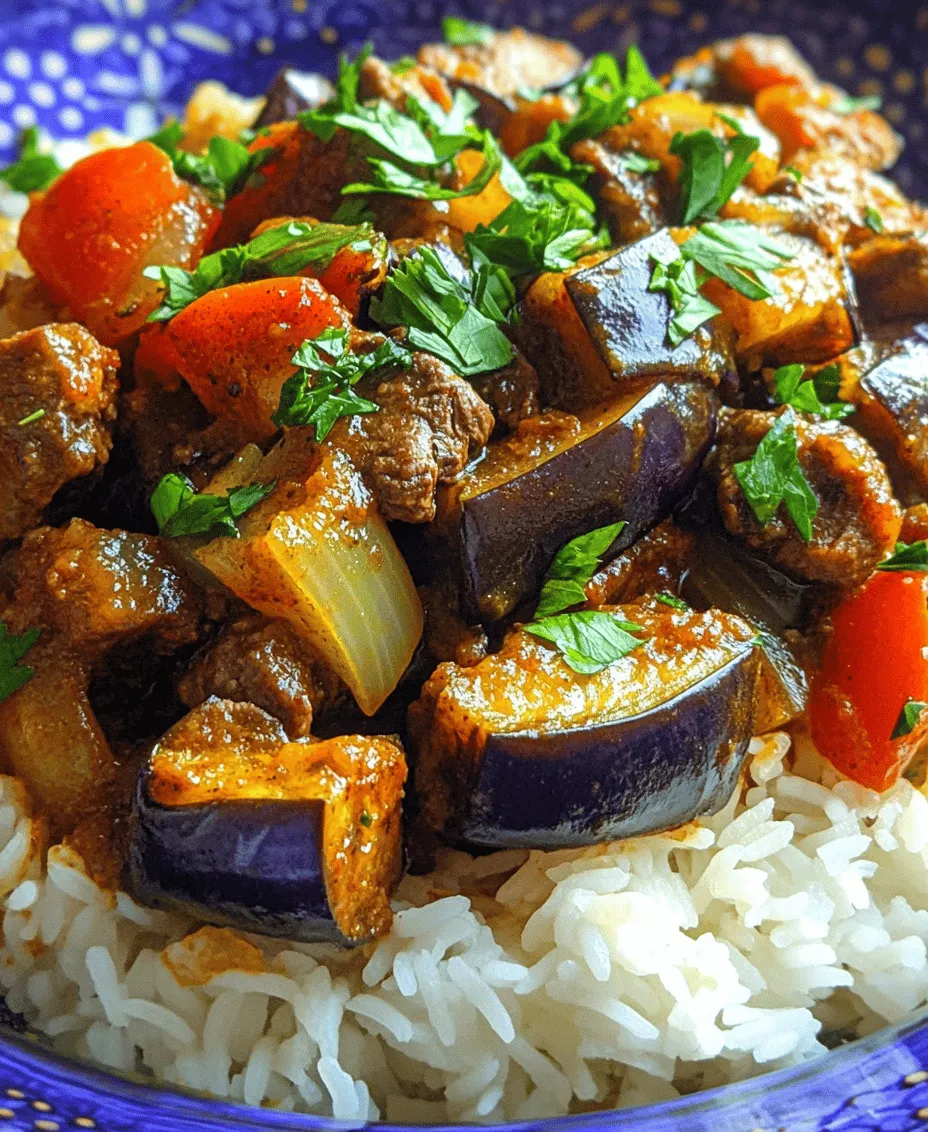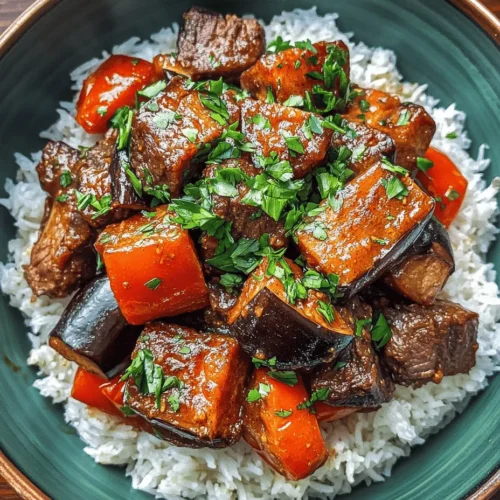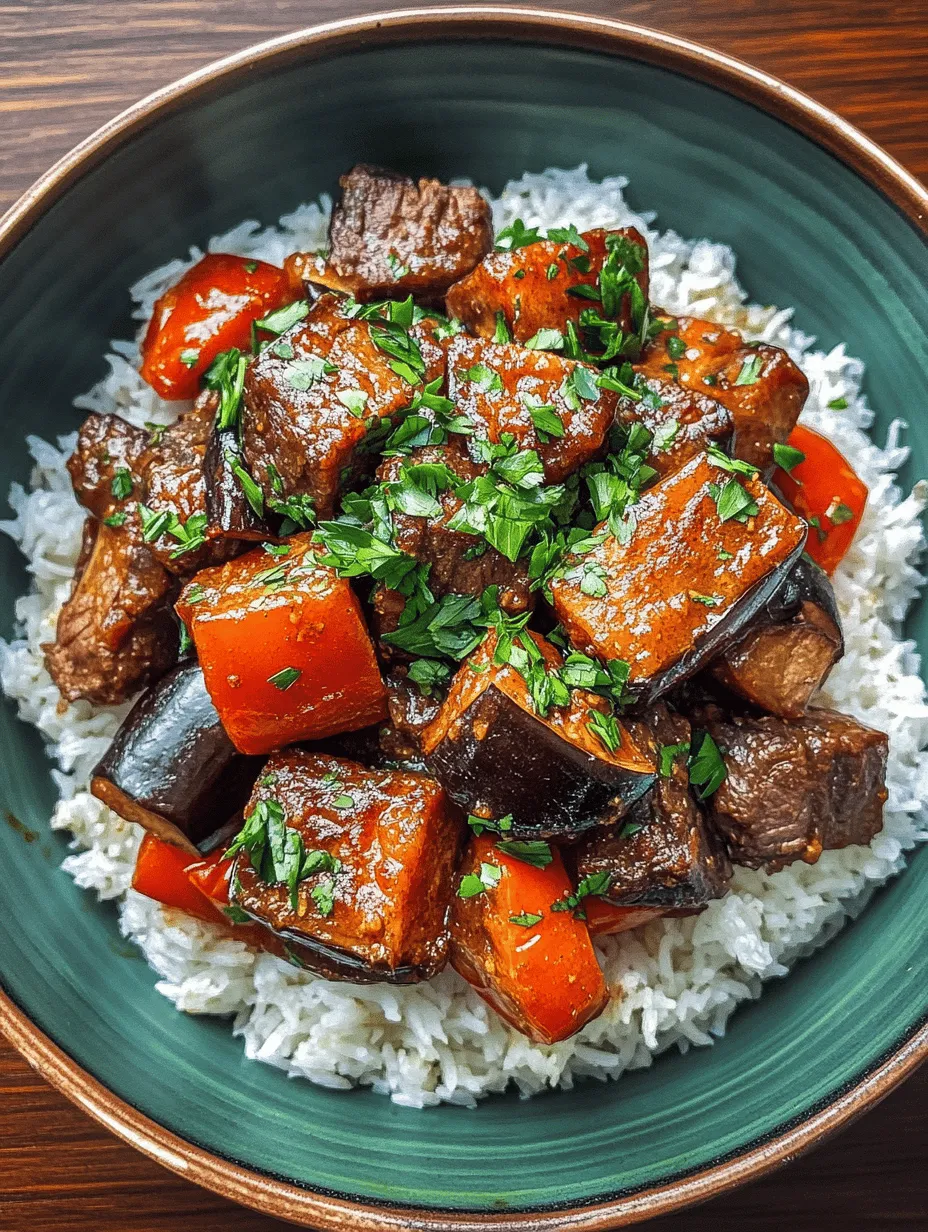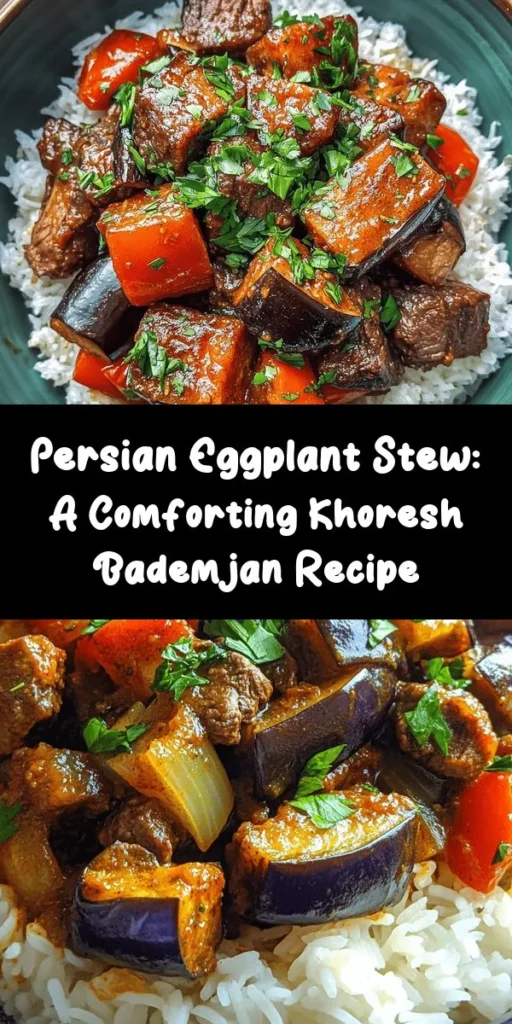Introduction
Khoresh Bademjan is a celebrated dish within Persian cuisine, revered for its rich flavors and heartwarming qualities. This Persian eggplant stew is not just a meal; it embodies the essence of family gatherings and the warmth of home-cooked food. The dish is a staple in many Iranian households, often served alongside fragrant basmati rice, creating a comforting and satisfying dining experience.
At its core, Khoresh Bademjan combines the lush, creamy texture of eggplants with tender meat (or vegetarian options) in a beautifully spiced sauce. The key ingredients—eggplants, onions, garlic, tomatoes, and a blend of aromatic spices—work harmoniously to create a dish that resonates with tradition and love. Each bite tells a story of heritage, making Khoresh Bademjan a must-try for anyone looking to explore the depths of Persian culinary art.
The Essence of Khoresh Bademjan
The term “Khoresh” translates to “stew” in Persian, and it represents a category of dishes that are slow-cooked and bursting with flavor. Khoresh Bademjan is a perfect illustration of this concept, as it requires time and care to develop its complex flavors. This stew is often seen as a centerpiece during family meals, especially during festive occasions and gatherings, reinforcing the idea that food is a means of connection and celebration.
Eggplants hold a special place in Persian cooking, not only for their versatility but also for their ability to absorb flavors, enhancing the overall taste of the dish. In Khoresh Bademjan, they take center stage, providing a creamy texture that contrasts beautifully with the tender meat. The cultural importance of eggplants is highlighted through their use in various Persian dishes, showcasing their adaptability in both vegetarian and meat-based recipes.
Across Iran, Khoresh Bademjan can vary significantly from region to region, with each locality adding its unique twist to the dish. In some areas, you may find the addition of sour plums (aloo) or even dried limes, while in others, saffron might be incorporated to elevate the aroma and flavor. These regional variations reflect the rich tapestry of Iranian culture, where food becomes a canvas for creativity and personal expression.
Ingredients Breakdown
To create a truly authentic Khoresh Bademjan, it’s essential to understand the role of each ingredient and how they contribute to the dish’s overall flavor profile. Here’s a detailed breakdown of the key components:
Eggplants
Eggplants are the star of Khoresh Bademjan, and their selection can greatly influence the dish. The most common variety used in Persian cooking is the large, purple eggplant, known for its meaty texture and ability to absorb spices.
When preparing eggplants for the stew, it’s crucial to draw out their moisture and bitterness. One effective method is to slice the eggplants, sprinkle them with salt, and let them sit for about 30 minutes. This process helps to remove excess water and any bitterness, resulting in a more flavorful end product. After salting, rinse the slices under cold water and pat them dry before cooking.
Onions and Garlic
Onions and garlic form the aromatic base of Khoresh Bademjan. Onions are typically sautéed until golden brown, providing a sweet and rich flavor that complements the other ingredients. Garlic adds an essential layer of depth to the dish, enhancing the overall aroma. Together, they create a fragrant foundation that sets the stage for the stew’s complexity.
Meat Options
While Khoresh Bademjan can be made with various types of meat, lamb and beef are the most popular choices. Lamb lends a rich, savory flavor that pairs beautifully with the eggplants, while beef offers a heartier option. For those seeking vegetarian alternatives, chickpeas or lentils can be used instead, providing protein and texture without compromising the dish’s integrity.
Tomatoes
Tomatoes, whether fresh or canned, are integral to the stew’s sauce. Fresh tomatoes provide a bright acidity that balances the richness of the eggplants and meat, while canned tomatoes offer convenience and a consistent flavor. When using fresh tomatoes, it’s advisable to peel and chop them before adding them to the pot for a smoother sauce.
Broth
The choice of broth can significantly impact the flavor of Khoresh Bademjan. While beef broth enhances the meaty essence of the dish, vegetable broth can be a suitable substitute for those opting for a vegetarian version. It’s essential to select a high-quality broth to ensure the stew remains flavorful and satisfying.
Spices and Seasonings
Spices are what elevate Khoresh Bademjan to a culinary masterpiece. The primary spices used in this dish include turmeric, cinnamon, black pepper, and salt. Turmeric gives the stew its vibrant golden hue and earthy flavor, while cinnamon adds warmth and a hint of sweetness. Black pepper provides a mild heat, and salt helps to enhance all the flavors. Each spice contributes to the harmonious blend that defines Persian cuisine, making Khoresh Bademjan a dish rich in both taste and tradition.
Preparation Steps in Detail
Once the ingredients are gathered, it’s time to start the cooking process. Here are the detailed preparation steps to create a perfect Khoresh Bademjan:
Preparing the Eggplants
The first step in preparing Khoresh Bademjan is to tackle the eggplants. As mentioned earlier, slicing and salting the eggplants is crucial to enhance their flavor and texture. After salting them and allowing them to drain for about 30 minutes, rinse off the excess salt and moisture. This step will ensure that the eggplants do not become soggy during cooking.
Frying Techniques
Frying the eggplants before adding them to the stew is a traditional technique that enhances their flavor and texture. Heat a generous amount of oil in a skillet over medium-high heat. Once the oil is hot, add the eggplant slices in batches, making sure not to overcrowd the pan. Fry them until they are golden brown on both sides, about 3-4 minutes per side. This frying process adds a layer of complexity to the dish, creating a slight caramelization that brings out the eggplant’s natural sweetness.
Sautéing Aromatics
With the eggplants fried to perfection, it’s time to build the flavor with the aromatics. In a large pot, heat some oil over medium heat and add finely chopped onions. Sauté the onions until they turn golden brown, which should take about 8-10 minutes. The browning of the onions is crucial, as it adds sweetness and depth to the stew. Once the onions are ready, add minced garlic and sauté for an additional minute until fragrant.
Browning the Meat (Optional)
If you choose to include meat in your Khoresh Bademjan, browning it is an essential step. In the same pot with the sautéed onions and garlic, add your choice of meat. Make sure to cut the meat into bite-sized pieces for even cooking. Increase the heat to medium-high and sear the meat until it is browned on all sides. This process locks in the juices and enhances the overall flavor of the stew.
As you continue with the preparation, keep in mind that each step contributes to the final dish’s richness and depth. The care taken during this initial phase sets the foundation for a memorable Khoresh Bademjan experience.
With this foundational understanding of Khoresh Bademjan, you are now equipped to explore the next steps in crafting this delightful Persian stew. The balance of flavors, the comforting texture, and the cultural significance make Khoresh Bademjan a dish worth mastering in any home kitchen.

Incorporating Spices and Tomatoes: The Process of Layering Flavors
When preparing Khoresh Bademjan, the art of layering flavors is essential for creating a rich and satisfying dish. Start by heating your cooking oil in a large pot over medium heat. Once hot, add finely chopped onions and sauté them until they turn golden brown. This caramelization process not only adds depth to the dish but also brings a natural sweetness to balance the savory components.
Next, it’s time to introduce the spices. Common spices used in Khoresh Bademjan include turmeric, cumin, and black pepper. Adding these spices at this stage allows their essential oils to release, infusing the oil with flavor. After the spices are fragrant, incorporate diced tomatoes or tomato paste, which adds acidity and sweetness to the stew, enhancing the overall flavor profile. Allow this mixture to cook for a few minutes until the tomatoes soften and meld with the spices, creating a vibrant base for the stew.
Combining Ingredients: How the Simmering Process Melds Flavors Together
Once the spice and tomato base is ready, it’s time to add the main ingredients: eggplants and your choice of protein (typically lamb or beef, but feel free to use chickpeas or lentils for a vegetarian version). Layering the eggplants on top of the base allows them to absorb the flavors without losing their structure. Cover the pot, allowing the ingredients to simmer gently.
As the stew cooks, the eggplants will soften and contribute their creamy texture to the dish. The simmering process is crucial as it melds the flavors together, allowing the spices to permeate the eggplants and the protein. Aim for a cooking time of about 1.5 to 2 hours on low heat, stirring occasionally, to ensure even cooking and prevent sticking. The slow simmering will result in a tender, flavorful stew.
Adjusting Seasoning: Understanding Personal Preferences in Taste
Taste-testing your Khoresh Bademjan towards the end of the cooking process is vital. Depending on your personal preferences, you may want to adjust the seasoning. Consider adding salt, pepper, or a hint of lemon juice to brighten the flavors. If your stew is too thick, splash in some water or vegetable broth to achieve your desired consistency. This final adjustment can elevate your dish, ensuring it suits your taste perfectly.
Cooking Techniques and Tips
Stovetop vs. Slow Cooker: Discussing Alternative Methods for Preparing Khoresh Bademjan
Khoresh Bademjan can be made using various cooking methods. The stovetop method, as described above, allows for direct supervision and frequent adjustments. However, if you prefer a hands-off approach, a slow cooker is an excellent alternative.
For slow cooking, combine your sautéed onions, tomatoes, spices, eggplants, and protein in the slow cooker. Set it on low for 6-8 hours or high for 3-4 hours. This technique allows the flavors to develop even further, making it a convenient option for busy days or meal prep.
Adjusting Cooking Times for Vegetarian Versions: How to Ensure Flavors Develop Without Meat
If you’re opting for a vegetarian version of Khoresh Bademjan, the cooking time may differ slightly depending on the protein substitute you choose. For instance, if using lentils or chickpeas, ensure they are pre-cooked or canned to reduce overall cooking time. Aim for a simmering duration of about 45 minutes to an hour, allowing the lentils to absorb the flavors without becoming mushy.
The Art of Garnishing: How Fresh Herbs Enhance Presentation and Flavor
Garnishing Khoresh Bademjan is an essential step that not only enhances its visual appeal but also adds a burst of freshness. Fresh herbs like parsley, cilantro, or mint complement the rich flavors of the stew beautifully. Simply chop the herbs finely and sprinkle them on top just before serving. This not only elevates the dish’s presentation but also infuses a fresh aroma that balances the hearty stew.
Serving Suggestions
Ideal Accompaniments: Traditional Basmati Rice and Its Importance in Persian Meals
Khoresh Bademjan is traditionally served with fluffy basmati rice, which serves as the perfect vehicle for soaking up the flavorful stew. The rice’s delicate, nutty flavor and slightly fragrant aroma make it an ideal base. When preparing your rice, remember to rinse it thoroughly to remove excess starch, which helps achieve that desired fluffy texture.
You can also choose to prepare saffron-infused rice for a special touch, enhancing both the color and flavor of your dish.
Suggested Garnishes: Fresh Herbs and Optional Lemon Juice for Brightness
In addition to fresh herbs, a squeeze of fresh lemon juice can elevate Khoresh Bademjan significantly. The acidity from the lemon juice adds a refreshing brightness that cuts through the richness of the eggplant and meat. Serve lemon wedges on the side, allowing guests to add their desired amount.
Variations in Serving: Exploring How Khoresh Bademjan Can Be Served During Different Occasions
Khoresh Bademjan can be served in various ways depending on the occasion. For a casual family dinner, serve it alongside a simple salad and warm bread. For a more festive gathering, consider presenting the stew in a large serving dish, surrounded by an array of sides such as roasted vegetables, pickled cucumbers, and yogurt. This communal style of dining reflects Persian hospitality and encourages sharing and conversation.
Nutritional Insights
Overview of the Nutritional Benefits of the Main Ingredients
Khoresh Bademjan is not only delicious but also packed with nutritional benefits. Eggplants are rich in antioxidants, particularly nasunin, which helps protect brain health, and they are a low-calorie vegetable high in fiber. The dish’s spices, such as turmeric, add anti-inflammatory properties, while the proteins from meat or legumes provide essential amino acids necessary for body function.
Discussion on the Balance of Flavors and Nutrients in the Dish
The balance of flavors in Khoresh Bademjan reflects a thoughtful combination of savory, sweet, and tangy elements, ensuring a well-rounded meal. The fiber from the eggplants and any added legumes promotes digestive health, while the healthy fats from the cooking oil contribute to satiety and flavor. This balance makes Khoresh Bademjan a wholesome option for any meal.
Vegetarian vs. Meat-Based Nutritional Comparisons
When comparing vegetarian and meat-based versions of Khoresh Bademjan, the nutritional profile varies. The meat version provides higher protein content, while the vegetarian option is lower in calories and saturated fats. Both versions offer essential vitamins and minerals, making them nutritious choices. Adjusting the ingredient ratios allows for customization based on dietary needs, ensuring everyone can enjoy this hearty dish.
Cultural Significance and Traditions
How Khoresh Bademjan Is Served During Special Occasions and Holidays
Khoresh Bademjan holds a special place in Persian cuisine, often served during family gatherings, holidays, and festive occasions. Its rich flavor and comforting nature make it a beloved dish among many Persian families. On special occasions, it’s not uncommon for families to prepare large pots of Khoresh Bademjan to share with friends and relatives, emphasizing the communal aspect of Persian dining.
Personal Anecdotes or Stories from Families Who Cherish This Dish
Many families have cherished stories surrounding Khoresh Bademjan, often passed down through generations. For instance, a grandmother might recall how she used to make it for family gatherings, sharing tales of how her children and grandchildren would gather around the table, eagerly waiting for the first spoonful. These anecdotes reflect the dish’s role in bringing families together, creating lasting memories over shared meals.
The Role of Communal Cooking and Sharing in Persian Culture
In Persian culture, communal cooking and sharing meals are essential aspects of family life. Khoresh Bademjan is often prepared in large quantities to accommodate family and friends, fostering connection and togetherness. The act of sharing food is seen as a form of love and hospitality, embodying the Persian value of treating guests with warmth and generosity.
Conclusion
Khoresh Bademjan is more than just a dish; it embodies the essence of Persian cuisine and culture. Its comforting flavors and versatility make it a staple in many households. Whether you choose to prepare it traditionally with meat or opt for a vegetarian version, the dish promises to deliver a rich tapestry of taste and aroma that brings people together.
We encourage you to try making Khoresh Bademjan at home to experience the warmth and hospitality of Persian culture. As you savor each bite, you’ll not only enjoy a delicious meal but also partake in a rich culinary tradition that has been cherished for generations. Embrace the versatility of this recipe, and let it inspire you to create your own family stories around the dinner table.



